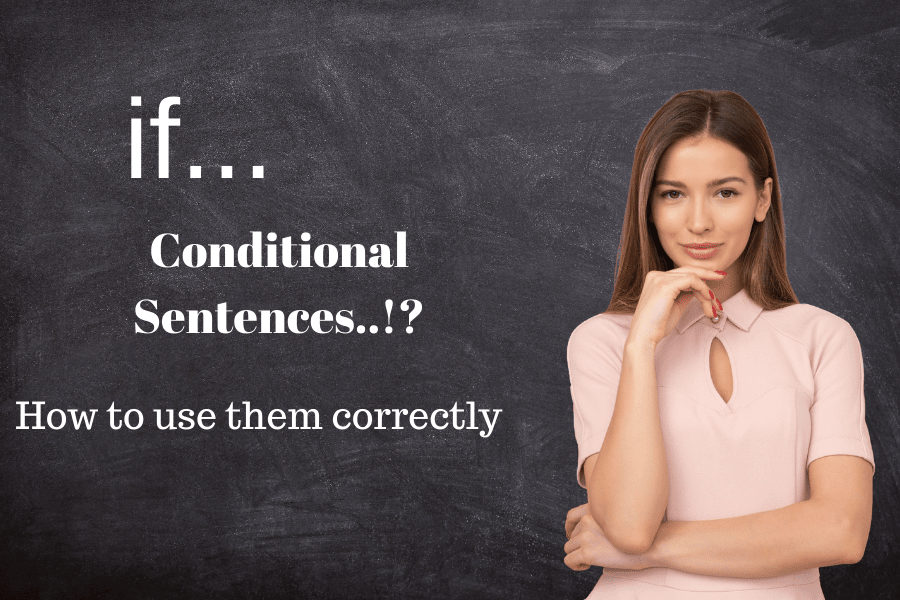Understanding Conditional Sentences
Conditional sentences are used to express situations and their potential outcomes based on certain conditions. There are different types of conditional sentences based on the likelihood or reality of the condition being met.
In this article, you will learn how to use conditionals in English grammar, including the structure of “if clauses” and their corresponding main clauses.
Basically, there are 4 different types of conditionals (zero, first, second, and third)
Zero Conditional (Real Condition):
Firstly, the zero conditional, also known as the real conditional, is used to express general truths or facts, describing what happens in real-life situations. It is formed with the simple present tense in both clauses. Therefore, we construct and use the zero conditional like this:
Structure:
- If Clause: If + simple present tense
- Main Clause: Simple present tense
Example:
- If it rains, the ground gets wet.
In this example:
- If Clause (condition): “If it rains” (simple present tense)
- Main Clause (result): “The ground gets wet” (simple present tense)
Usage:
- The zero conditional is used to talk about things that are generally true or happen in real-life situations.
- It expresses a cause-and-effect relationship that is always true or predictable.
More Examples:
- If you heat ice, it melts.
- If you mix red and yellow, you get orange.
- If you drop a ball, it falls to the ground.
In summary, the zero conditional is a simple way to describe factual situations or truths using the present tense in both the “if” clause and the main clause.
First Conditional (Likely Condition):
Second, the first conditional, also known as the likely conditional, is used to talk about future possibilities or consequences that are likely to happen based on a certain condition. It is formed with the simple present tense in the if clause and the future (usually with “will” or “going to” + base form of the verb) in the main clause. You will learn below how to construct and use the first conditional:
Structure:
- If Clause: If + simple present tense
- Main Clause: Future (will + base form of the verb / going to + base form of the verb)
Example:
- If it rains tomorrow, I will stay indoors.
In this example:
- If Clause (condition): “If it rains tomorrow” (simple present tense)
- Main Clause (result): “I will stay indoors” (future with ‘will’ + base form of the verb)
Usage:
- The first conditional is used to talk about possible future events or outcomes that are likely to happen based on a specific condition being met.
- It suggests a cause-and-effect relationship where the outcome is dependent on the condition being true in the future.
More Examples:
- If she studies hard, she will pass the exam.
- If you invite him, he will come to the party.
- If they finish their work on time, they are going to celebrate.
In Conclusion, the first conditional is used to discuss likely future results based on a specific condition, using the simple present tense in the if clause and a future form (will or going to) in the main clause. It helps express possibilities and expectations about future events.
Second Conditional (Unlikely Condition):
Third, the second conditional is used to talk about hypothetical or unlikely situations in the present or future. It is often used to discuss unreal or imaginary scenarios and their possible outcomes. So, the second conditional is formed with the simple past tense in the “if” clause and the conditional (would + base form of the verb) in the main clause. Here’s how to construct and use the second conditional:
Structure:
- If Clause: If + simple past tense
- Main Clause: Would + base form of the verb
Example:
- If I won the lottery, I would travel around the world.
In this example:
- If Clause (condition): “If I won the lottery” (simple past tense)
- Main Clause (result): “I would travel around the world” (conditional: would + base form of the verb)
Usage:
- The second conditional is used to talk about imaginary or unlikely situations and their potential outcomes.
- It is often used to express desires, dreams, or hypothetical scenarios that are not currently true or likely to happen.
More Examples:
- If I were President, I would make education free for everyone.
- If she spoke Spanish fluently, she would apply for the job in Madrid.
- If it rained tomorrow, we would stay indoors and watch movies.
In summary, the second conditional is used to discuss unreal or unlikely situations in the present or future, using the simple past tense in the if clause and the conditional (would + base form of the verb) in the main clause. It helps express hypothetical scenarios and their potential consequences.
Third Conditional (Past Unreal Condition):
Fourth and last, the third conditional is used to talk about hypothetical or unreal situations in the past and their imagined outcomes. It describes a situation that did not happen in the past and imagines what the result would have been if things had been different. Therefore, the third conditional is formed with the past perfect tense in the “if” clause and the conditional perfect (would have + past participle) in the main clause. Here’s how to construct and use the third conditional:
Structure:
- If Clause: If + past perfect tense (had + past participle)
- Main Clause: Would have + past participle
Example:
- If she had studied harder, she would have passed the exam.
In this example:
- If Clause (condition): “If she had studied harder” (past perfect tense: had + past participle)
- Main Clause (result): “she would have passed the exam” (conditional perfect: would have + past participle)
Usage:
- The third conditional is used to talk about imagined outcomes or regrets related to past events that did not occur.
- It describes a hypothetical past situation and its imagined consequence if things had been different.
More Examples:
- If I had known you were coming, I would have baked a cake.
- If they had taken the earlier flight, they would have arrived on time.
- If he had listened to the weather forecast, he wouldn’t have forgotten his umbrella.
In the end, the third conditional is used to discuss unreal or hypothetical situations in the past, expressing what could have happened differently if certain conditions had been met. It uses the past perfect tense in the if clause and the conditional perfect in the main clause to describe these imagined scenarios and their outcomes.
Summarizing
Overall, remember there are 4 types to express conditional sentences in English using “if”. In addition, either you start the clause with “if” or with the main clause without adding a comma. For instance:
- I would buy a house if I had enough money.
Don’t forget to write a conditional sentence down in the comment section.


